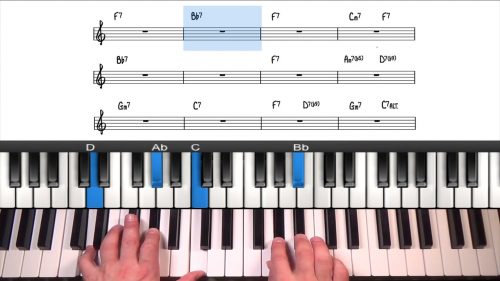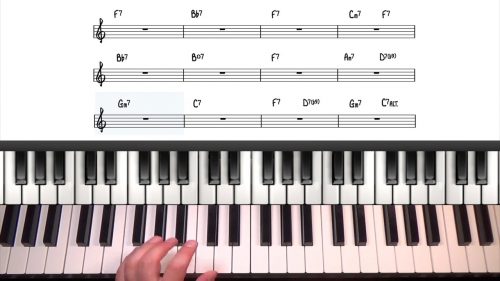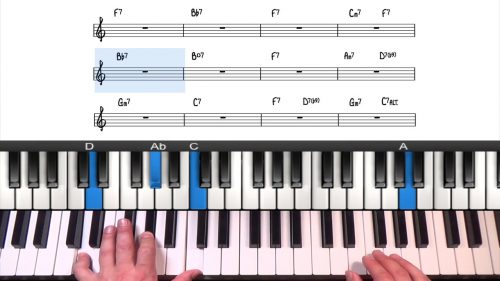Georgia On My Mind Solo Piano Tutorial
In part 1 of Georgia, we introduced the concept of the major blues scale and the extended blues scale. In this lesson we take it a step further by applying this scale to the tune Georgia On My Mind.
To start this tutorial, we play through the form again adding some bigger, more interesting voicings and applying more advanced harmony including altered voicings and upper structure triads.
The minor line cliche appears multiple times in the form and so we explore the different ways we can navigate through this common progression. The minor to major movement can be voiced at the top of the chord, in the middle, or at the bottom as a bass line. We use all 3 of these option to create a varied arrangement.
Throughout the form we incorporate bluesy fills and licks in the upper registers. To create a full sounding arrangement, we then balance this with use of bass notes in the lower registers of the piano.
The melody also lends itself to pasing chords. We use dominat passing chords to create energy and forward motion which drives the tune forward. Passing chords in the lower registers work particualy well after blues licks and lines in the right hand.
Practice Tips
-
Analyse the scale degree formulas of the gospel-infused lines and licks and transpose these around a few different keys.
-
You will find that they work better in some keys than others.
-
The C, F & G blues scales are similar in their shape and so it's easy to transpose lines between these keys.
-
When you transcribe a lick or a line, first look to transpose into the 'similar keys' in terms of their shape on the keyboard.





This is excellent. Great arrangement and lesson
Awesome thanks Michael. I also like this arrangement and the gospel/bluesy vibe! Cheers, Hayden
Any more like this Hayden? I originally joined this site to learn to play blues + jazz especially those cool licks and reharmonizations. I’ve cycled through all the beginner lessons and standards, now I’m in the intermediate section and hoping to find more stuff on reharmonizations and blues licks.
From what I found on reharm so far you talk about tri-tone subs and block chords/drop 2. Wondering if you have more tips like the one you did for misty where you mentioned 4ths are ambiguous in tonality (?) so they’re good for reharm.
Cheers
Hi Tobi,
You might like this lesson that Tuomo presents on the tune “Manhattan”: https://www.pianogroove.com/jazz-piano-lessons/manhattan-tutorial/
Tuomo shows a 1625 progression transcribed from Oscar Peterson.
Manhattan is also played in the key of F Major – the same key that we play Georgia – and so you could use that exact introduction for this tune too. That could be fun to experiment with.
I have also added more bluesy tunes to our upcoming lesson schedule for you.
Cheers!
Hayden
Dope, looking forward to it!
People can’t believe I taught myself how to play the piano without having any music background. I think anyone can do it with this site so keep up the good work.
You mention at the beginning that this is part 2 of the tutorial, but I wasn’t able to find part 1. Would you mind linking it?
Thanks!
Hi Albert,
Apologies for the late reply here.
Part 1 is the first lesson in this course entitled “The Major Blues Scale – Georgia”.
Here’s the lesson: https://www.pianogroove.com/blues-piano-lessons/the-major-blues-scale/
Let me know if I can be of further assistance.
Cheers, Hayden
Could you point me to the link for Part 1? Is it how to read the lead sheet for Georgia? I’m kind of confused
Hi Hayden
Just read Alberts comment and your reply about Part 1
My apologies.
I got the answer now for Part 1
Outstanding arrangement Hayden. 🙂
Cheers, Glenn
Nice one Hayden! Loving the sound of those #11 Chords!